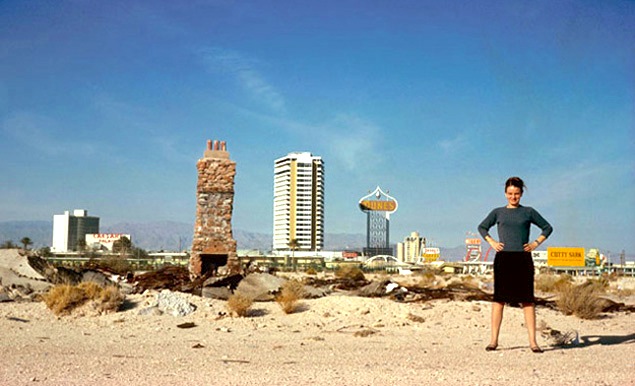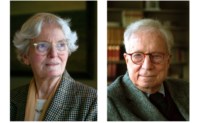
There’s a long shadow hanging over the AIA Gold Medal for 2015. Yesterday, the institute announced that Moshe Safdie is next year’s winner—a surprise for those who were expecting Robert Venturi and Denise Scott Brown to get the prize. This was the first year Venturi and Scott Brown were jointly eligible because of a change in the rules to allow two architects to win the award together. That change was made in the wake of the movement last year to amend the 1991 Pritzker Prize, which was awarded solely to Venturi and never acknowledged Scott Brown’s role in their body of work.
Venturi and Scott Brown were one of the three finalists considered for the Gold Medal this year, in what a source described as a close vote. “You can cogitate all you like about why it happened,” Denise Scott Brown said after learning that the couple had lost. “I’ve had very long years of not getting the job—and not getting this and that—and it’s not ripping my flesh off.”
Billie Tsien, who presented to the AIA jury on behalf of Venturi Scott Brown, was practically in tears when she called Scott Brown to deliver the news. “It was truly devastating,” said Tsien. “I was surprised—not to suggest we were overly confident. We felt very strong and positive in what we had to say about their career and impact. Their legacy deserves to be recognized.”
Each presenter is allowed to speak for 12 minutes and to show up to 40 slides to make their case. First was John Enright speaking on behalf of the third finalist, Eric Owen Moss; then Richard Saul Wurman for Safdie; and then Tsien for Venturi Scott Brown. The presenters then left the room while the AIA jury deliberated and voted.
One source said that it was so close between Safdie and Venturi Scott Brown, that it required several rounds of voting to determine a winner.
Frank Gehry, who wrote a letter of support for Safdie, also wrote on behalf of Venturi Scott Brown. Past AIA Gold Medal winners Richard Meier, Michael Graves, Antoine Predock, and Princeton President Christopher Eisgruber also wrote on the duo’s behalf.
Venturi and Scott Brown had submitted materials for a nomination five times in the past but were never considered because—in act of defiance—they only sought the Gold Medal jointly. Over the years, some friends urged them to pay attention to the rules and submit separately. “Bob and I were ornery, and for 30 years, we didn’t do what the AIA wanted,” said Scott Brown.
As the movement to amend the 1991 Pritzker Prize to include Scott Brown grew in force (there are nearly 20,000 signatures on an online petition today), the late New York architect Frederic Schwartz, who had worked in the Venturi Scott Brown office, mounted a campaign to change the AIA Gold Medal rules. He went to various state and local chapters to get their backing. “Fred said, ‘Denise, let me do this,’” she recalled. “He was dying—it was his last gift to us. That was the real award.”
Scott Brown is taking the news of the Gold Medal loss in stride. “Maybe we’ll do it again next year,” she said.
Letter to the Editor from Caroline James
To the Editor:
In response to Architectural Record's December 11, 2014 news story, "AIA Chooses Moshe Safdie Over Venturi Scott Brown for Gold Medal"
Inclusion, Recognition, and the 2015 AIA Gold Medal Decision
The AIA National Jury announced their decision last month to award the Gold Medal to Moshe Safdie, an esteemed architect and educator whose work and influence spans many continents. The outcome, however, was surprising and disappointing to supporters of Denise Scott Brown and Robert Venturi. Many feel that their recognition by the AIA’s highest professional honor is long overdue. “Why didn’t they win?” they asked. As one of the spearheads with Arielle Assouline-Lichten and Women in Design of the Petition to Recognize Denise Scott Brown for her role in the Pritzker Prize, I would like to set this decision in the context of the last few years and the years to come.
The 2015 Gold Medal round was the first in history when the application for Venturi and Scott Brown was opened, considered, and embraced. Over three decades, many had urged Bob to apply on his own, but he refused to go for the Gold alone. Each of their joint applications was returned owing to old eligibility requirements that have since been amended. The placing of Bob and Denise among the finalists constitutes a momentous recognition of joint creativity in design.
Assembling the Gold Medal nomination is a thorough process, brought forth by teams of supporters for each applicant who network with architects and others and secure letters of recommendation. For Bob and Denise, this support came from the profession, legacy firms, University Presidents, and architectural historians. Seven former Gold Medalists, perhaps a record-setting number, wrote letters on their behalf. The National AIA Committee on Design served as the official nominating entity.
Billie Tsien, principal of New York-based Tod Williams Billie Tsien Architects, delivered the presentation at AIA National Headquarters. “I felt a big responsibility to make the presentation,” Tsien said, “It is the right thing to do. We know that architecture comes from many hands, but joint creativity is a mysterious and indescribable trait. The work that they’ve done is so intertwined.” Tsien’s presentation is historic, for it reveals the nature of their shared creative output.
Kem Hinton, FAIA, of Nashville’s Tuck-Hinton Architects, headed this year’s application with the help of many, including Julia Donoho, AIA, Esq. and Harry Bolick, VSBA Inc. Hinton added, “The late Fred Schwartz, FAIA, and his partner, editor and writer Tracey Hummer, led this effort with the support of so many across the nation. Having witnessed the remarkable collaboration of Denise and Bob, I am elated at the progress. Now onward to the next swing at the bat for this dynamic duo.”
On the evening that the Gold Medal decision was announced, I spoke with Denise, who underscored the positive impacts and progress in the profession over the last two years that cannot be taken away:
Positive #1: Julia Morgan in 2014 became the first woman architect to receive the AIA Gold Medal, over 60 years after her death. She was as prolific as Frank Lloyd Wright in terms of output, building over 700 projects, including Hearst Castle.
Positive #2: The AIA amended the rules to allow partners to receive the Gold Medal for the first time. Eligibility guidelines for the Gold Medal now state: “Any individual (not necessarily an American or an architect); or two individuals working together (but only if their collaborative efforts over time are recognized as having created a singular body of distinguished architectural work) ….”
Positive #3: Denise said the Pritzker Petition brought much “love” to architecture. This was her compliment to nearly 20,000 signers, many of whom made statements on change.org that communicate their support, and also wider thoughts and concerns about the profession. Denise interprets the Petition as a social document—a datum on where architecture stands in 2013-2014. In her 2013 lecture at the Harvard Graduate School of Design, she elaborated, calling petitioners’ comments, “Mayhew’s Architecture,” in reference to an historic report on conditions of workers in London during the Industrial Revolution.
The 2015 Gold Medal round and these positive outcomes are all part of a process towards understanding and resolving issues of inclusion within a contemporary context. It’s not without fits and starts, and it’s not just for partners, or women, or Denise Scott Brown. Women in Design, the Missing 32% Project, and the Beverly Willis Architecture Foundation have joined organizations worldwide in leading the charge towards an inclusive and diverse profession that recognizes all its constituents. Many overlapping dialogues and controversies are shifting the course of the profession and recent events suggest the efforts are succeeding. Bob and Denise’s supporters will likely re-nominate them next year for the AIA Gold Medal. This year’s jury and supporters are enthusiastic in recommending they should. Everything considered here suggests the same.
Caroline James
Women in Design
Cambridge, MA
January 6, 2015





Post a comment to this article
Report Abusive Comment